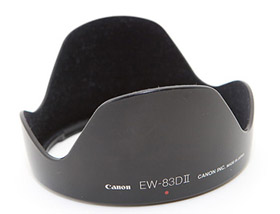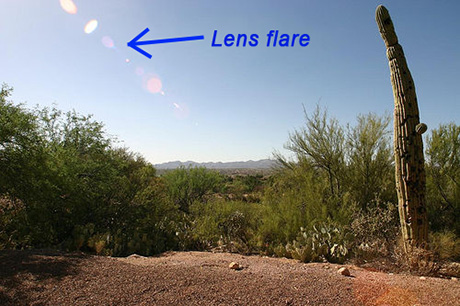
So, to help remedy this problem and motivate you to always use a lens hood (if you’re not already!), here are two great things they can do for you:
#1 – Prevents lens flare
The main purpose of the lens hood is to prevent lens flare:

Lens flare will show up in your photos when the Sun is shining on your lens (but still outside the field of view of the lens). Although lens flare can sometimes add a cool effect to a photo, it’s usually an unwanted problem that makes your photos appear hazy and washed out.
So, to help prevent the Sun from shining on your lens, always remember to use a lens hood!
Another tip: sometimes the lens hood doesn’t always keep the Sun off your lens, so it’s helpful to carry around some kind of large object that you can use to help block the Sun in these situations. Any kind of hat works well for this, and sometimes you can even just use your hand to block the Sun. Just make sure whatever you’re using doesn’t show up in the photo! 😉
#2 – Protects your lens
The lens hood can also provide a lot of protection for your lens, since it adds a large buffer of space between the glass and the outside world. Not only does this protect your lens if you accidentally drop it, but it also helps prevent dust and dirt from blowing onto the glass.
This added protection lets you walk around without a lens cap, which helps keep you ready for an action shot of wildlife.
Not all lenses come with hoods
The lens hood isn’t always included when you buy a new lens, but they’re available to purchase separately for most lenses. So, if your lens didn’t come with a hood, check the manufacturer’s website to see if one is available.
If you enjoyed this article, and would like to read more, please signup for our free email newsletter.
 About the Author: Steve Berardi is a naturalist, photographer, software engineer, and founder of PhotoNaturalist. You can usually find him hiking in the beautiful mountains and deserts of southern California.
About the Author: Steve Berardi is a naturalist, photographer, software engineer, and founder of PhotoNaturalist. You can usually find him hiking in the beautiful mountains and deserts of southern California.

Hi Steve.
While a lens hood certainly does the job it was designed for fairly well it does have its draw backs.
While I am guilty of being one who wears his hood backwards, I do so for a valid reason. Have you ever tried to use a circular polarizing filter with a lens hood on correctly? Unless you have fingers the size of an infant it’s next to impossible to rotate the filter.
But as for protecting the lens, yes, on the occasions where I have had the hood on correctly it has saved my lens from tree branch scrapes and curious fingers from small children.
Thanks for the article.
Dear Steve – many thanks for lens hood info. There is one more reason involving physics. As light strikes glass at 90 degrees it passes through directly, but when the light ray strikes glass at an angle it gets refracted inside the glass and exits glass parallel to striking angle. But as light strikes at an angle called critical angle it does not pass through but gets reflected and also causes total internal reflection/s causing an effect like halo, mist and chromatic aberation at the edges. The camera lenses are very complex and complicated, they are are convex, concave, plano convex and such 12 to 14 elements in each lens. Imagine what havoc it will cause due to several intrenal reflections. So simple solution is cut
the light ray of critical angle by fixing the lens hood.
You do, however, have to watch for unwanted vignetting when using wide angle lenses with a lens hood.
Thanks for the article. i love the usefulness of your ideas. Coulc you possibly offer a discussion as to whether there is a way to deal with vignetting by adding mulifple control filters to the front of your lenses if they have a wide angle opening? i have had problems with adding a protection filter to my camera to protect the lens and then adding a circular polarizing filter to darken the sky. the lens is 28-80 mm and if i epen it to even 28, i get the vinyetting. Is there a way to address this other than taking off the protection filter each time you add another?
Jim Hyatt
I understand the logic behind using lens hoods, but I just don’t like them and they rarely leave my house with me. I use circular polarizers a lot and lens hoods really get in the way when using them, and if you have the hood on backwards it gets in the way of manual focusing. I always have some sort of filter on my lens so I figure they cover the protection side of things.
Keith – I agree, it’s pretty annoying to use a polarizing filter and a lens hood together. I usually take off the hood to adjust the polarizer where I want it, then put the hood back on (and make sure I didn’t accidentally move the polarizer while reattaching the hood).
shashikant – Thanks so much for sharing that great explanation!
Tom – I think most lens hoods that were made for a specific lens should account for that vignetting at wide angles. I know my Canon 17-40mm does, and a few others I’ve tried.
James – great idea! I’ll add that topic to my list of post ideas 🙂
Jenessa – I agree, lens hoods can definitely be annoying sometimes, especially with polarizing filters.